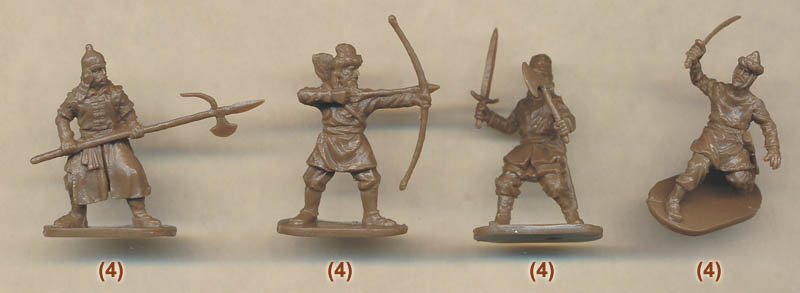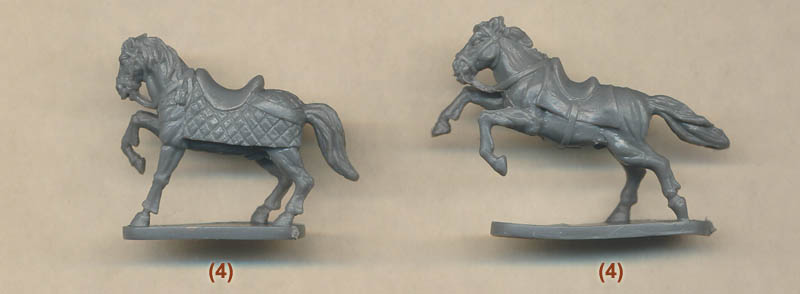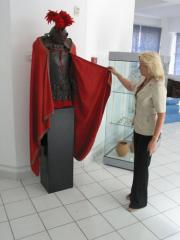



 All figures are supplied unpainted (Numbers of each pose in brackets)
All figures are supplied unpainted (Numbers of each pose in brackets)  Stats Date Released 2009 Contents 34 figures and 8 horses Poses 11 poses, 2 horse poses Material Plastic (Medium Consistency) Colours Brown/Grey Average Height 24.5 mm (= 1.77 m)
Stats Date Released 2009 Contents 34 figures and 8 horses Poses 11 poses, 2 horse poses Material Plastic (Medium Consistency) Colours Brown/Grey Average Height 24.5 mm (= 1.77 m) 
 Review
Review Vlad Tepes is little known outside his native lands, or at least little understood. Born around 1431, he ruled Wallachia (which is in modern Romania) as voivod or prince for several periods between 1448 and his death in 1476. Wallachia was a turbulent land, caught as it was between Hungary and the vigorous Ottoman Empire, both of which claimed suzerainty over it at various times. Along with these neighbours, who were always happy to interfere in local politics, a restless and disloyal local aristocracy made governing such a land a challenging and dangerous task, and the frequent changes of ruler were often accompanied by violence and death. In an age when princes often used terror to get their way, Vlad became known for the extremes to which he would go, both in the sheer number of his victims and in the gruesome nature of his apparent favourite form of execution – impalement on a wooden stake (hence ‘Tepes’ – ‘the impaler’). Much of his energies were directed toward fighting the expanding Ottoman Empire, which he personally hated, thus providing something of a buffer between that empire and Western Europe.
In common with many armies of the time the armed forces of Wallachia were made up of two parts – the ‘Lesser Army’, which was comprised of professional soldiers, foreign mercenaries, loyal retainers and some selected peasants and townsmen, and the ‘Greater Army’ or voinici, which was effectively a general levy of all able-bodied males called out in emergencies. Only the retainers and wealthier soldiers wore much armour, while the peasantry wore their normal clothes with no more than a padded jacket for protection. Inevitably given their location Wallachian warriors were influenced by Hungary and other middle-European countries to the west, by the Russian states to the north, and by the Ottomans to the east. The peasantry were similar in appearance to their Russian contemporaries, with warm tunic, trousers and boots and often a fur-trimmed cap. The main weapon was the composite bow but various other types such as swords, clubs etc were also used. The wealthier and professional soldiers might wear armour of eastern or western influence, and used swords, spears and maces amongst others.
The foot figures in this set are a cross-section of Wallachian forces, with the majority of poses being of the poorer levies without any armour. The styles of clothing are all authentic, as are the weapons apart from the bow, which seems to be a longbow rather than the far more usual composite bow. The first figure in the top row has an eastern-looking helmet and holds a spear or polearm. Obviously not part of the levy, he illustrates more clearly the eastern influence on wealthier soldiers, and to a lesser extent so does the man with the banner. The pose next to the banner man is evidently Vlad himself, and is based on the most famous portrait of the man and on a modern reconstruction produced by Angus McBride. The cap with its impressive plume is a direct copy, and the coat is typical of the nobility of the time, with its eastern false sleeves. Despite this figure holding a sword aloft this is not the costume Vlad would have worn in battle, but instead ordinary court dress. In battle he would have worn armour of a high quality not greatly dissimilar to that worn by more western princes.
Much Wallachian cavalry was light and unarmoured, which is a fair description of the two mounted figures in this set. Although mounted troops tended to be professional or wealthy the swordsman is quite simply dressed, which the bowman, who this time has a far more acceptable type of bow, is more richly attired. Neither man wears spurs, which is quite correct, but surprisingly the swordsman has no stirrups either. One horse has some quilted protection but both are suitable for this type of warrior and well executed.
While many will not have heard of Vlad the Impaler, everyone has heard of the fictional character Dracula created by Bram Stoker at the end of the 19th century. Dracula was Vlad’s surname, and meant son of Dracul (Dracul being his father’s name since he joined the Order of the Dragon). Apart from his name there is little connection between Vlad and the fictional vampire count, yet simply putting the word Drakul on the box seems to have been reason enough for Lucky Toys to have included a figure of the classic character in very classic pose. A nice touch but of no relevance to the historical subject of the rest of the set.
All the poses here are really great and have lots of life as well as being perfectly appropriate for the subject. Their style is the same as the Caesar figures, and this extends to the several figures with complex stances that can only be obtained by multiple part or flexible moulds. This makes the poses anything but flat and greatly enhances their look, particularly as there is no assembly required here, nor even any separate weapons. The falling man in the top row is a highlight, as is the downed man in the second and the mounted swordsman, who is striking to his right, but all of them are excellent.
The sculpting is first class, with all the detail you could possibly want and perfect proportions. The banner has been somewhat crudely engraved with a design on both sides, but this is easily painted over, and there is no flash or other excess plastic to spoil any figure. The riders sit on their mounts fairly easily, and even the traditional long hair of all the men is beautifully realised, so there really isn’t much more you could ask for.
However we would ask for more. These figures are great and a fair cross-section of an army under Vlad, but only 10 poses is far too few to deliver a full army as a wargamer might require. The mounted arm in particular is hardly going to be properly depicted with just two poses, so as with some earlier Lucky Toys sets this is more a selection of suitable soldiers than a serious attempt to depict an entire army. True other figures could be gained from sets of Russians and others, but we can’t help admiring these figures and wishing there were many more. That aside, these are fabulous figures for a fascinating era.
 Ratings
Ratings Historical Accuracy
 10 Pose Quality
10 Pose Quality  10 Pose Number
10 Pose Number  4 Sculpting
4 Sculpting  10 Mould
10 Mould  10
10Ce spuneti de asta? Se apuca omul si achizitioneaza Russian Foot Soldiers de la Zvezda, ca deh ceva mai apropiat cica nu exista, si poftim surpriza...placuta bineinteles!
Oricum exista numai 10 ipostaze asa ca "rusnacii" merg in completare de minune.
Cand aflati de unde se poate achizitiona un set va rog sa ma anuntati si pe mine
Aceasta postare a fost editata de dodos: 08 February 2010 - 12:42 AM


 Ajutor
Ajutor



 Sus
Sus







